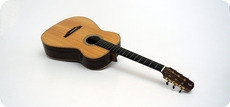Tone Woods
Tops:
Tops are normally made using Engelmann Spruce, Western Red Cedar, or occasionally Sitka Spruce.
All of my top woods have been in storage at my shop for at least 20 years. While grain count and coloration are important, there are other factors that go into selecting top wood. Characteristics such as specific gravity and stiffness which directly affect the sound quality are also primary factors in the choice of sound boards.
Engelmann Spruce
The Engelmann Spruce I use is all from the Northwestern US. This wood has a very nice bell-like sound quality, and instruments made with this wood produce an elegant sound.
Sitka Spruce
Although this wood is abundant, only a small subset of specimens are appropriate for my nylon-string guitars. This is one of the strongest types of spruce, which makes it generally more suitable for steel-string guitars. However, Sitka spruce that is somewhat less dense produces a strong, dry sound that responds well to being played hard.
Western Red Cedar
Compared to spruce, my cedar-topped guitars have a somewhat darker sound in the lower registers, which some people prefer, while maintaining excellent clarity in the upper registers. Like all the instruments I build, my cedar-topped guitars have more than adequate volume.
I also use two less common varieties of Western Red Cedar, the first being from the Rocky Mountains. Sometimes referred to as “Mountain Cedar”, it has a very blonde coloration, higher grain count, and is lighter and stronger than typical Western Red. Another variety I occasionally use is darker, and varies in color from coffee to chocolate brown.
Sides & Backs:
East Indian Rosewood
This is a traditional material for sides and backs. This is a beautiful tone wood, which is very stable. I use two different types of Indian Rosewood in my guitars. The more common type comes from southern India; this wood's coloration varies from purple to dark purple with browns and subtle reds. Indian Rosewood from the north, near the base of the Himalayas is a little less dark than the southern wood, and exhibits a warmer coloration, with browns, oranges and subtle reds.
Brasilian Rosewood
As a result of international treaties, this wood is no longer commercially harvested. Quality specimens of this wood are becoming exceedingly rare and costly. The best Brasilian Rosewood has its own unique rich, dark beauty. This exceptional beauty is not without drawbacks however, as this wood tends to be a bit less stable than some other types of Rosewood. All of my Brasilian Rosewood has been harvested legally.
Madagascar Rosewood
The Madagascar Rosewood I use is frequently referred to as "Rio" Rosewood by those who harvest it, alluding to its similarity in appearance to fine Brasilian Rosewood. It has the beauty of Brasilian Rosewood, but with the stability of East Indian Rosewood. In many ways this is the best of both worlds. It is starting to become more difficult to find premium specimens of Madagascar Rosewood, and of course, prices are rising also.
Cocobolo
This exotic wood is also a true Rosewood. It has a unique coloration with red, black and brown grain lines. This is one of the heavier woods I use for sides and backs.
Instrument sold
Prenkert Guitars, USA
Contact name:
Richard Prenkert
Brands:
Languages:
English
Specialties:
Hand-built Guitars
Opening hours:
By appointment.
Proudly built guitars that are easy to play with excellent volume, sustain and tonal quality.
Usually, instruments must be ordered, and can be delivered in approximately 3-6 months. Occasionally, there may an instrument available on shorter notice.
Builder
Price:
EUR 4.990,-
Location:
Germany
20% OFF
Builder
Price:
EUR 4.000,-
Location:
Germany
Builder
Price:
EUR 2.706,-
Location:
Canada
Builder
Price:
Call for price
Location:
Canada
Builder
Price:
EUR 2.906,-
Location:
Sweden
Builder
Price:
Call for price
Location:
Switzerland













